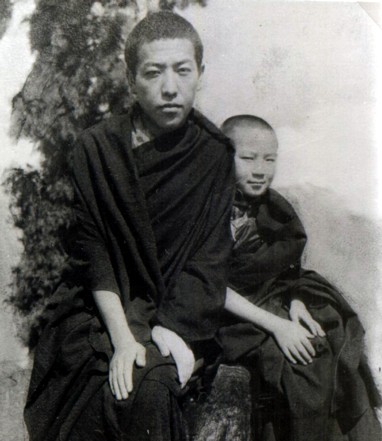Thartse Khen Rinpoche: Difference between revisions
No edit summary |
No edit summary |
||
| Line 1: | Line 1: | ||
[[Image:Thartse Khen and Sogyal Rinpoche.JPG|frame|'''Ngor Thartse Khen Rinpoche and Sogyal Rinpoche''']] | [[Image:Thartse Khen and Sogyal Rinpoche.JPG|frame|'''Ngor Thartse Khen Rinpoche and Sogyal Rinpoche''']] | ||
'''Ngor Thartse Khenpo Sonam Gyatso Rinpoche''' aka '''Hiroshi Sonami''' (1930-1988)<ref>[[Dhongthog Rinpoche]]'s autobiography gives his dates as 1933-1987.</ref> — a disciple of [[Jamyang Khyentse Chökyi Lodrö]]. Khen Rinpoche was born into a noble family in [[Lhasa]]. His father, Tsipon Shuguba, Treasurer of the central government of Tibet, after 19 years of imprisonment | '''Ngor Thartse Khenpo Sonam Gyatso Rinpoche''' aka '''Hiroshi Sonami''' (1930-1988)<ref>[[Dhongthog Rinpoche]]'s autobiography gives his dates as 1933-1987.</ref> — a disciple of [[Jamyang Khyentse Chökyi Lodrö]]. Khen Rinpoche was born into a noble family in [[Lhasa]]. His father, Tsipon Shuguba, was Treasurer of the central government of Tibet under HH the [[Dalai Lama]]. Tsipon Shugba, after 19 years of imprisonment, was brought to America by his sons in 1980. During the Tsipon's imprisonment time he also endured the deaths of his daughter and his wife, who departed this life by means of [[Phowa]] on the eve of her 'show trial' by the Communist authorities. Tsipon Shugba wrote ''In the Presence of My Enemies: Memoirs of Tibetan Nobleman''<ref>Clearlight Publishers, 1995.</ref>. | ||
Sonam Gyatso was recognized by the 39th Kyabgön [[Throneholders of the Sakya school|Sayka Trizin]] Dragshul Thinley Rinchen and enthroned as | Sonam Gyatso was recognized by the 39th Kyabgön [[Throneholders of the Sakya school|Sayka Trizin]] Dragshul Thinley Rinchen as the incarnation of the previous Great Abbot of [[Ngor]] and enthroned as Great Abbot of [[Ngor Monastery|Ngor Thartse Monastery]]. One of Khen Rinpoche's brothers, who was recognized as a [[Gelugpa]] tulku, today lives in Switzerland. His younger brother, Lama Kunga Rinpoche, who is founder and resident lama of Ewam Choden ([[Sakya|Sakyapa]]) Tibetan Buddhist Center in Berkeley, California, was born in 1935 and recognized as the [[tulku]] of Sevan Repa, one of the heart-sons of [[Milarepa]], and initially lived in a [[Kagyu]] monastery but found Ngor Thartse Monastery more congenial and became a Sakyapa lama. The two brothers escaped from Tibet in 1958, with Khen Rinpoche managing to save Ngor Monastery's famed collection of [[mandala]] [[thangka]]s. Subsequently, Khen Rinpoche worked in the Tibetan section of the National Library of Japan (hence the alternate name of Hiroshi Sonami, a Japanese rendering of Sonam Gyatso) and authored a book on the Ngor Collection. | ||
Khen Rinpoche subsequently relocated to Berkeley, California, where he lived until he departed this realm due to stomach cancer. A deeply humble and compassionate man, he lived quietly, engaged in his studies and meditation. At the time of his death, Khen Rinpoche was translating an important [[Abhidharma]] text. Khen Rinpoche sometimes remarked that there | Khen Rinpoche subsequently relocated to Berkeley, California, where he lived until he departed this realm due to stomach cancer. A deeply humble and compassionate man, he lived quietly, engaged in his studies and meditation. At the time of his death, Khen Rinpoche was translating an important [[Abhidharma]] text. Khen Rinpoche sometimes casually remarked that there must have been a mistake when he was enthroned as one of the highest ranking tulkus in the Sakya School. However, this observation was seen by his devoted friends and followers as yet one more example of his profound realization by putting himself below others. | ||
==Publications== | ==Publications== | ||
Revision as of 20:06, 1 January 2009

Ngor Thartse Khenpo Sonam Gyatso Rinpoche aka Hiroshi Sonami (1930-1988)[1] — a disciple of Jamyang Khyentse Chökyi Lodrö. Khen Rinpoche was born into a noble family in Lhasa. His father, Tsipon Shuguba, was Treasurer of the central government of Tibet under HH the Dalai Lama. Tsipon Shugba, after 19 years of imprisonment, was brought to America by his sons in 1980. During the Tsipon's imprisonment time he also endured the deaths of his daughter and his wife, who departed this life by means of Phowa on the eve of her 'show trial' by the Communist authorities. Tsipon Shugba wrote In the Presence of My Enemies: Memoirs of Tibetan Nobleman[2].
Sonam Gyatso was recognized by the 39th Kyabgön Sayka Trizin Dragshul Thinley Rinchen as the incarnation of the previous Great Abbot of Ngor and enthroned as Great Abbot of Ngor Thartse Monastery. One of Khen Rinpoche's brothers, who was recognized as a Gelugpa tulku, today lives in Switzerland. His younger brother, Lama Kunga Rinpoche, who is founder and resident lama of Ewam Choden (Sakyapa) Tibetan Buddhist Center in Berkeley, California, was born in 1935 and recognized as the tulku of Sevan Repa, one of the heart-sons of Milarepa, and initially lived in a Kagyu monastery but found Ngor Thartse Monastery more congenial and became a Sakyapa lama. The two brothers escaped from Tibet in 1958, with Khen Rinpoche managing to save Ngor Monastery's famed collection of mandala thangkas. Subsequently, Khen Rinpoche worked in the Tibetan section of the National Library of Japan (hence the alternate name of Hiroshi Sonami, a Japanese rendering of Sonam Gyatso) and authored a book on the Ngor Collection.
Khen Rinpoche subsequently relocated to Berkeley, California, where he lived until he departed this realm due to stomach cancer. A deeply humble and compassionate man, he lived quietly, engaged in his studies and meditation. At the time of his death, Khen Rinpoche was translating an important Abhidharma text. Khen Rinpoche sometimes casually remarked that there must have been a mistake when he was enthroned as one of the highest ranking tulkus in the Sakya School. However, this observation was seen by his devoted friends and followers as yet one more example of his profound realization by putting himself below others.
Publications
- Ngor Thartse Khenpo Sonam Gyatso (bSod nams rgya Mtsho), Tibetan Mandalas: The Ngor Collection, Tokyo, Kodansha, 1983
Notes
- ↑ Dhongthog Rinpoche's autobiography gives his dates as 1933-1987.
- ↑ Clearlight Publishers, 1995.